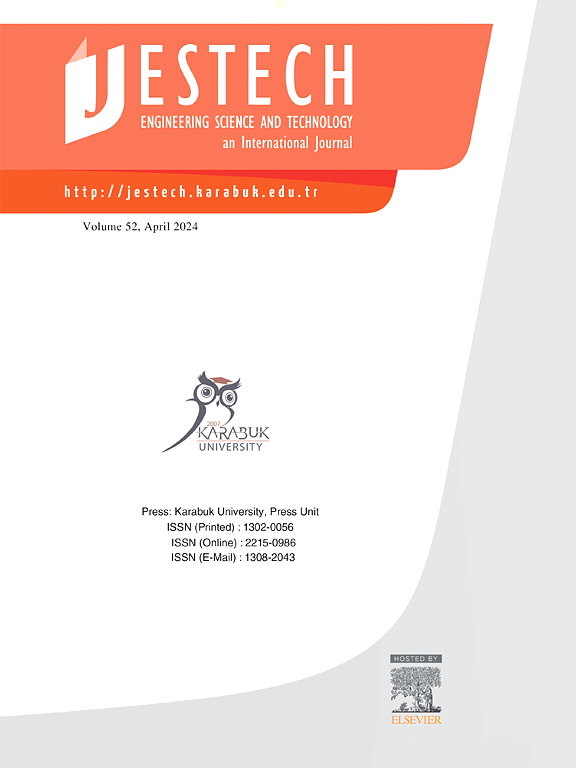纺织废水可持续生物处理的营养补充策略优化
IF 5.4
2区 工程技术
Q1 ENGINEERING, MULTIDISCIPLINARY
Engineering Science and Technology-An International Journal-Jestech
Pub Date : 2025-06-06
DOI:10.1016/j.jestch.2025.102102
引用次数: 0
摘要
随着工业化、城市化进程的加快和气候变化的影响越来越大,人们越来越关注改善各个部门的废水处理过程。纺织工业是全球最大的用水和废水产生部门之一,在生物处理方面面临重大挑战,特别是由于营养缺乏,主要是氮(N)和磷(P)。本研究通过评估适当的营养补充来优化纺织废水处理厂的生物处理效率,从而解决了这些缺陷。根据原水的特性和目前的处理工艺,计算了所需的营养量。评估了几种添加方案,包括动物粪便(鸡鸽)和合成肥料[磷酸二铵(DAP)和DAP +尿素]。结果表明,最有效的方案是每天添加13.37 kg DAP和68.13 kg尿素。这些替代品的日常成本计算为:动物粪便278欧元,DAP 202.5欧元,DAP +尿素73.5欧元。经济分析表明,添加DAP +尿素是最具成本效益的方案。营养优化使化学处理相关的运营成本降低了38%。这种方法还有望减少工厂的碳足迹,并对减缓气候变化作出积极贡献。未来的研究将探索天然营养来源,并通过中试研究评估其对治疗效率的影响。这项工作强调了通过改善特定部门的废水处理来节约成本和环境效益的潜力。本文章由计算机程序翻译,如有差异,请以英文原文为准。
Optimizing nutrient supplementation strategies for sustainable biological treatment of textile wastewater
With increasing industrialization, urbanization, and the growing impacts of climate change, there is a heightened focus on improving wastewater treatment processes across various sectors. The textile industry—one of the largest water-consuming and wastewater-producing sectors globally—faces major challenges in biological treatment, particularly due to nutrient deficiencies, mainly nitrogen (N) and phosphorus (P). This study addresses these deficiencies by evaluating appropriate nutrient supplementation to optimize biological treatment efficiency at a textile wastewater treatment plant. Based on raw wastewater characterization and current treatment processes, the required nutrient amounts were calculated. Several supplementation scenarios, including animal manures (chicken-pigeon) and synthetic fertilizers [di-ammonium phosphate (DAP) and DAP + urea], were assessed. Results showed that the most effective option was the addition of 13.37 kg of DAP and 68.13 kg of urea daily. The daily costs of these alternatives were calculated as €278 for animal manures, €202.5 for DAP, and €73.5 for DAP + urea. Economic analysis revealed that DAP + urea supplementation was the most cost-effective solution. Nutrient optimization led to a 38 % reduction in operating costs related to chemical treatment. This approach is also expected to reduce the plant’s carbon footprint and contribute positively to climate change mitigation. Future research will explore natural nutrient sources and assess their impacts on treatment efficiency through pilot-scale studies. This work highlights the potential for both cost savings and environmental benefits through sector-specific improvements in wastewater treatment.
求助全文
通过发布文献求助,成功后即可免费获取论文全文。
去求助
来源期刊

Engineering Science and Technology-An International Journal-Jestech
Materials Science-Electronic, Optical and Magnetic Materials
CiteScore
11.20
自引率
3.50%
发文量
153
审稿时长
22 days
期刊介绍:
Engineering Science and Technology, an International Journal (JESTECH) (formerly Technology), a peer-reviewed quarterly engineering journal, publishes both theoretical and experimental high quality papers of permanent interest, not previously published in journals, in the field of engineering and applied science which aims to promote the theory and practice of technology and engineering. In addition to peer-reviewed original research papers, the Editorial Board welcomes original research reports, state-of-the-art reviews and communications in the broadly defined field of engineering science and technology.
The scope of JESTECH includes a wide spectrum of subjects including:
-Electrical/Electronics and Computer Engineering (Biomedical Engineering and Instrumentation; Coding, Cryptography, and Information Protection; Communications, Networks, Mobile Computing and Distributed Systems; Compilers and Operating Systems; Computer Architecture, Parallel Processing, and Dependability; Computer Vision and Robotics; Control Theory; Electromagnetic Waves, Microwave Techniques and Antennas; Embedded Systems; Integrated Circuits, VLSI Design, Testing, and CAD; Microelectromechanical Systems; Microelectronics, and Electronic Devices and Circuits; Power, Energy and Energy Conversion Systems; Signal, Image, and Speech Processing)
-Mechanical and Civil Engineering (Automotive Technologies; Biomechanics; Construction Materials; Design and Manufacturing; Dynamics and Control; Energy Generation, Utilization, Conversion, and Storage; Fluid Mechanics and Hydraulics; Heat and Mass Transfer; Micro-Nano Sciences; Renewable and Sustainable Energy Technologies; Robotics and Mechatronics; Solid Mechanics and Structure; Thermal Sciences)
-Metallurgical and Materials Engineering (Advanced Materials Science; Biomaterials; Ceramic and Inorgnanic Materials; Electronic-Magnetic Materials; Energy and Environment; Materials Characterizastion; Metallurgy; Polymers and Nanocomposites)
 求助内容:
求助内容: 应助结果提醒方式:
应助结果提醒方式:


